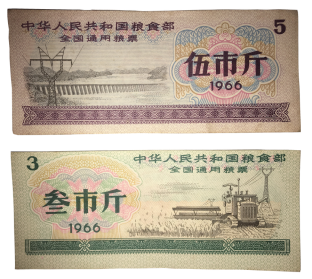
全国粮票是指全国通用粮票,不论你走到什么地方,都可以用此粮票购买粮食用品,其中还包括食油(只有全国粮票才可以在异地买食油)。若要出差或探亲,一定要用地方粮票换上一定数量的全国粮票才能出门。1966年版的全国通用粮票,可谓是家喻户晓,人人皆知,在人们的心目中,它可是粮票的代名词。当时老百姓都把她视如珍宝,不是特殊情况,根本舍不得使用她,现在很多人的箱子里抽屉里,都能找出来。尤其是这枚五市斤的,三市斤的。
National Food Ticket refers to the national general grain ticket, wherever you go, you can use this food ticket to buy food supplies, including cooking oil (only the national food ticket can buy cooking oil in other places). If you want to travel or visit relatives, you must use local food stamps for a certain number of national food stamps to go out. The 1966 edition of the national food stamp is well known to everyone. In people’s minds, it is the synonym of the food stamp. At that time, the common people regarded her as a treasure, not a special case, and were reluctant to use her at all. Now, many people can find her in their boxes and drawers. Especially this five-city-kilogram one and three-city-kilogram one.
粮票是在六、七十年代粮食供应紧张时期,国家为避免不法之徒跨区域倒买倒卖抬物价以至饿死人的现象出现,不得已出台的各地发行各自的粮票,老百姓按人口领取后凭票就可以买到平价的口粮的制度。地方粮票是我国在特定的经济时期发放的,由各省、市、自治区粮食局印发,为方便人们购买粮食并作为购买凭证的工具,也是我国计划经济时期的见证,是人们计划经济时期应用最广泛的,影响力最深的物证。粮票作为一种实际的有价证券,在中国使用40年,它放映了中国各个历史时期的社会经济状况。然而随着时间的流逝,经济的发展,粮票早已经悄无声息的退居二线了。现如今,地方粮票已经逐渐显示了它的独特的文化历史身份了,这种文物越来越少,对于收藏界来说,不管是什么藏品,最主要的就是“物以稀为贵”现在的地方粮票存世量越来越少了,自然就有了收藏价值。
Food tickets are in the period of food supply shortage in the 1960s and 1970s。 In order to avoid the phenomenon of illegal people buying and selling food across regions, raising prices and even starving people, the state has to issue their own food tickets everywhere。 People can buy parity rations on the basis of tickets after they are received by the population。 Local food stamps are issued by the grain bureaus of provinces, municipalities and autonomous regions in China in a specific economic period。
In order to facilitate people’s purchase of food and as a means of purchase vouchers, they are also witnesses of the planned economy period in China, and are the most widely used and influential material evidence in the planned economy period。 As a practical securities, grain tickets have been used in China for 40 years。 They reflect the social and economic conditions of China in various historical periods。 However, with the passage of time and the development of economy, food stamps have already quietly retreated to the second line。
Nowadays, the local food stamps have gradually shown their unique cultural and historical identity。 This kind of cultural relics is becoming fewer and fewer。 For the collectors, no matter what the collection is, the most important thing is that the local food stamps are less and less in the world, so they naturally have collection value。
粮票是特殊经济条件下的历史产物,地方粮票的历史绝非一般的文化娱乐史,而是一部凝重浑厚的中华民族创业史,是一部华夏子孙与贫穷,饥饿的抗争的生活史,是中国计划经济这段历史的真实写照和证明,具有着深刻历史意义的事件。在中国粮票的发展历程中,很多独具特色的粮票留存至今,以至发展成为很多藏家的留存珍品。
Food stamps are historical products under special economic conditions. The history of local food stamps is by no means a general history of cultural entertainment, but a solemn and profound history of the Chinese nation’s entrepreneurship, a life history of the struggle between Chinese descendants and poverty and hunger, a true portrayal and proof of the history of China’s planned economy, with a profound history. Meaningful events. In the course of the development of food stamps in China, many unique food stamps have been retained so far that they have become the preserved treasures of many Tibetans.
限 时 特 惠: 本站每日持续更新海量各大内部创业教程,一年会员只需98元,全站资源免费下载 点击查看详情
站 长 微 信: lzxmw777






